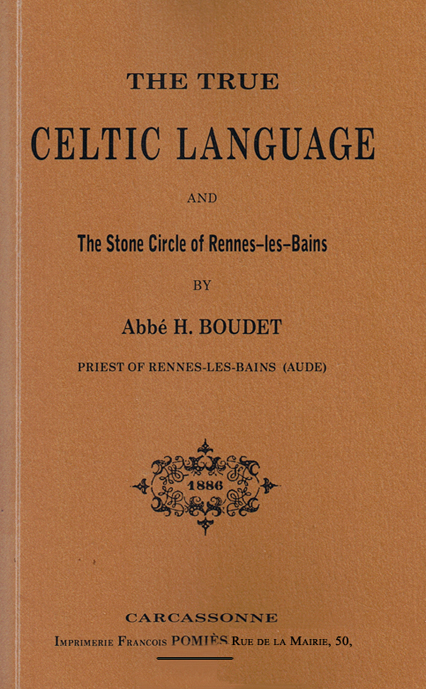The True Celtic Language
and
The Stone Circle of Rennes-les-Bains
Les Editions de L'Œil du Sphinx
Fac-similé de l'édition originale
« We dream that, after the analysis of certain deliberately obscured works, we may possess a secret which owes nothing to former knowledge, whether or not previously revealed. »
André Breton's dream of the lost book is not only well-placed amongst those who give birth to it. He is one of those very rare figures who allow it to become manifest.
That is why I like to wonder what thoughts the founder of surrealism would have drawn from this opaque work if he had known it and had approached its flame. It was he who pulled from the shadows those whom he once called the « Têtes d'orage » : Alphonse Rabbe, Xavier Forneret, Raymond Roussel and lastly Jean-Pierre Brisset, the inventor of the Grammaire logique which is not dissimilar, in some respects, to Boudet's magnum opus.
Like them, the author of La Vraie Langue Celtique et le Cromleck de Rennes-les-Bains deserves this title of « perfect nobody », which is more enviable than can be believed. I mean that he deserves to take his place amongst the Silent brilliant ones, inhabitants of this Forbidden City of the psyche where as mysteriously as wheat, the seed of language germinates.
Contains at the end a map in colour

PRELIMINARY OBERVATIONS
FIRST CHAPTER.
CELTIC LANGUAGE
I. Summary of the first occupation of the gauls
II. Celtic Language
III. Languedocien dialect and the Tectosages
IV. Languedician dialect and the true Celtic language
V. The Neimheid
CHAPTER II.
HEBREW LANGUAGE
I. The divine names
II. The first men. - Adam to Noah
III. Noah and his children
IV. Abraham and the patriarchs
V. Moses and the Hebrews in the desert
VI. Joshua. - Jesus the Saviour. - Goliath and David
CHAPTER III.
PUNIC LANGUAGE
I. Africa. - Phut. - Numidians and Moors
II. The generals of Carthage. - The Numidian Kings
III. Kabyle language
CHAPTER IV.
FAMILY OF JAPHETH
I. Gomer and his sons
II. Tubal and the Iberians
III. The Basque language
IV. The Cantabrians. - The Iberians. - The Kjoekken-Moeddings of Denmark
V. The Gascons. - The Occitani. - The Aquitani and their tribes. - Auch. - Bordeaux
CHAPTER V.
CELTIC LANGUAGE
I. The Armorici and its tribes
II. The Redones. - The Celtic monuments. - The Druids. - The Carnutes
III. The Rhone. - Marseille. - The Allobroges. - Lyon. - The Arverni and Vercingetorix
CHAPTER VI.
THE VOLCAE TECTOSAGES AND THE LANGUEDOC
I. The Volcae Tectosages and Arecomici. - The Belges. - The Garonne. - Toulouse. - The Gironde
II. The Languedoc. - The Wisigoths and the people called Barbares
III. The Franks. - Their origin
IV. The first Frankish kings
V. King Bebryx and Pyrene. - Hercules. - The Sardanes. - Caucoliberis. - Illiberis. - The Sordes
VI. The Atacini. - The Aude. - The floating timbers on the Aude. - Carcassonne
CHAPTER VII.
STONE CIRCLE OF RENNES-LES-BAINS
I. Description of the Drunemeton or stone circle of The Redones of southern Gaul, - menhirs, dolmens, rollers or rocking rocks. - The Goundhill or Sarrat plazent
II. Religious meaning of the stone circle, the menhirs, dolmens and rollers
III. Human sacrifices in Gaul
IV. The stone of Trou or Celtic axe
V. Secondary significance of the standing stones. - The Eubates
VI. The art of healing amongst the Druids.- The thermal and mineral waters of Rennes -les -Bains. Iron-bearing cold springs of the stone circle
VII. Spring of Notre-Dame de Marceille
VIII. The salty river and the fossilised molluscs
IX. The sacred mistletoe
CHAPTER VIII.
THE CELTIC VILLAGE OF RENNES-LES-BAINS
I. The Celtic homes. - The route for the chariots
II. Food of the Celts. - Gallic drinks
III. Boar hunting
IV. The Romans and the thermal spring of the Reine. - The cross in the stone circle of the Redones.
310 Pages

